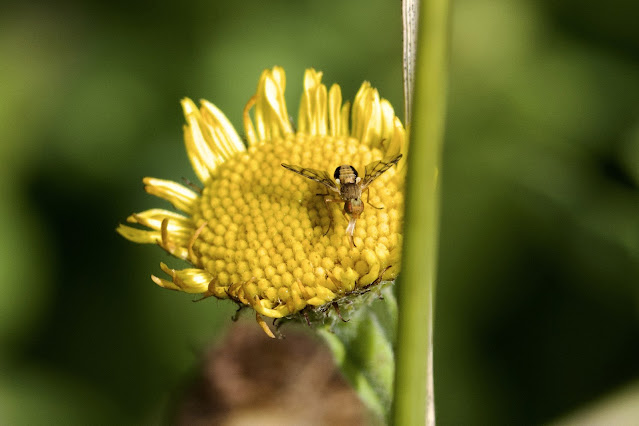For more than 20 years I have been in touch on and off with Professor Valery Korneyev, a Ukrainian entomologist now living in exile in Berlin. For some years he has been reviewing various genera of fruit flies Tephritidae and this year I was lucky enough to be in a position where I could help a bit with his research. These days, by the way, he is funded by the Humboldt Foundation Researchers at Risk fund at the Natural History Museum of Berlin. Back in Ukraine he is Collections Manager and Head of Entomology for the Schmalhausen Institute of Zoology of the National Academy of Sciences of Ukraine in Kyiv.
Valery posing with the postcard I sent him.
 |
| Photo courtesy of Professor Valery Korneyev. |
He wanted specimens of a tiny fly called Myopites blotii from France, preferably as close to Paris as possible. The fly causes galls in Common Fleabane Pulicaria dysenterica, so the easiest way to find the flies is to find a patch of fleabane.
Me checking fleabane flowers for galls in the field.
 |
| Photo courtesy of Ingrid de Winter. |
I enlisted my botanist contact Valérie Lagny to find a suitable location and she picked the Etang Purais, part of the LPO Chérine Reserve in the Brenne. This meant that if we wanted to take samples we would need permission, but it was for a good cause, so it was just a question of asking.
Me pooting flies. My pooter uses the venturi principle, so I blow in it and it sucks up tiny insects. It was made for me by my friend Paul.
 |
| Photo courtesy of Ingrid de Winter. |
On the day we had arranged to do the field work the weather was distinctly iffy, trying to rain all morning. Valérie took me to a nice big patch of fleabane and I set to work. The flies were not super abundant, but there were enough that I managed to collect 12 for Valery. I was impressed at how good Valérie had got at spotting the flies since they aren't in her normal line of work. My friend Ingrid, who is a Dutch nature guide and one of my swimming buddies, had also accompanied us and spent the morning practicing with her new camera.
Me on site at the Etang Purais. The fleabane is the yellow flowered plant.
 |
| Photo courtesy of Ingrid de Winter. |
Once home I put half the flies in alcohol to preserve them and the others in the freezer. Once I was ready to send them to Valery the frozen flies got gently transferred to kitchen paper impregnated with a little alcohol, then slid into a small box supplied by my friend Tim. Everything was labelled appropriately to show species name, date caught, location caught and who caught them.
Entomologists often stick their heads in their nets. It's a good way of seeing what you've got whilst blocking escape.
 |
| Photo courtesy of Ingrid de Winter. |
Everything was put into a snaplock bag then into a cardboard box sealed with lots of tape, along with a covering note on a postcard I'd picked up at the Polish Institute in Brussels in March. It seemed like the perfect moment to use it.
Myopites blotii on Common Fleabane Pulicaria dysenterica at the Etang Purais, Indre.
 |
| Photo courtesy of Ingrid de Winter. |
I posted the box to Valery in Berlin and he got it in two days. He says the flies arrived in good condition and he is really happy. I'm pleased. Valérie and I are now awaiting his scientific note on the species with interest.
Some of the specimens of Myopites blotii I collected for Valery. They are about 3 mm long.


3 comments:
"Me pooting flies. My pooter uses the venturi principle, so I blow in it and it sucks up tiny insects"
Now that's neat....
Is that fly the size of Drosophila, a.k.a. Mouche du Vinaigre in French?
chm: Drosophila are very slightly smaller, by about half a millimetre.
Post a Comment